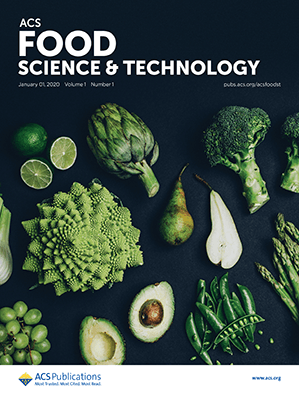Food Packaging is (Naturally) Getting Smarter
Food packaging and waste are two key issues in the race to address climate change—and they are often one and the same. But several recent studies present innovative solutions for intelligent, sustainable food packaging alternatives to petroleum-based plastics and synthetic dyes.

The food we eat has a dramatic impact on the planet. Much attention is given to the ecological consequences of mass farming, agriculture, and food production processes. But part of the challenge stems from two associated problems: increasing levels of food waste, and the ubiquitous use of plastics in food packaging. In fact, food packaging is the third largest global industry and the single-largest contributor to solid waste.1-3
Since most food packaging is either disposed of improperly or cannot be recycled at all, the damage caused by plastic debris and microplastics is also an important part of the conversation.2 Yet packaging is an essential need for many foods, preventing contamination and extending shelf life. This role in reducing food waste is crucial, since it is estimated that 17% of total global food production is wasted.3
Some argue that removing packaging altogether would result in a heavier dependence on refrigeration, which could drive the problem in a different way by further increasing energy usage and greenhouse gas emissions. So how can we address this issue without compromising hygiene and food quality?
Progress Toward Biodegradable Active Packaging
One proposed solution is through active packaging technology, which—when triggered by changes either to the product itself or to outside environmental conditions—works to release active compounds or isolate gaseous emissions within the package in order to extend freshness.1 Although the concept of active packaging has existed since the early 1900s, significant technological innovations have only begun to gain traction in recent years.
Lately, research in the field has been focusing on exclusively using biodegradable and biocompatible materials for active packaging technology. Options for natural antimicrobial biopolymers in active release packaging include corn starch, collagen, cellulose, and chitosan.1,4 Unfortunately, these biopolymers often have weaker material properties—such as mechanical strength and thermal stability—compared to conventional plastics, which must be improved upon before bio-based active packaging can be a safe, widely accepted solution.
Natural active agents, such as polyphenols from tea or essential oils from clove, marjoram, or thyme, may also be used as antimicrobials.1 Work is ongoing to ensure that the release of these active compounds from packaging can be strictly controlled in order to adhere to food safety regulations—and to ensure they do not affect the smell or taste of the food. Here, the food industry may borrow from medicine, where controlled-release drugs have become the norm in many therapeutic areas. This could mean it is possible to build a controlled-release food packaging environment where natural antimicrobials are induced by external stimuli such as heat or pH. And speaking of pH…
Giving New Meaning to Food Coloring
Another review in ACS Food Science & Technology also highlights more natural approaches to intelligent food packaging, focusing specifically on developments in pH-responsive color indicator technology.5 Color indicators on food packages have gained significant popularity in recent years, making it easier than ever for consumers to quickly assess the pH levels and freshness of foods with shorter shelf lives such as meats, dairy products, and seafood. But almost all current commercial pH indicators use synthetic dyes that could pose great health and safety risks if leaked from the packaging into the food itself.
As a solution, scientists have begun developing new color indicators made from pH-responsive natural colorants such as anthocyanins (found in produce and flowers); curcumin6 (derived from turmeric); alizarin and shikonin (root-derived); and betalains (found in beets). So far, indicators using these natural colorants have performed successfully on packaging for various animal-based food products. Despite their incredible potential, more research and testing must be conducted to further strengthen properties such as pH sensitivity and microbial marker detection before these natural colorant-based indicators make it to your local grocery store.
Many countries show signs of a desire to move towards reusable, recyclable, or compostable packaging, and the development of biodegradable packaging that can compete with plastics on a commercial level is fundamental to this revolution. To date, there have been few scalable successes in the field. But with the problems underpinning the need for sustainable and smart food packaging only growing, it is surely just a matter of time before the chemistry happening in the lab becomes mainstream.
Explore More Articles on Sustainable Food Packaging from ACS Publications
- Zare, M. et al. Emerging Trends for ZnO Nanoparticles and Their Applications in Food Packaging. ACS Food Sci. Technol. 2022, 2, 5, 763–781.
- Li, F. et al. A Naturally Derived Nanocomposite Film with Photodynamic Antibacterial Activity: New Prospect for Sustainable Food Packaging. ACS Appl. Mater. Interfaces 2021, 13, 44, 52998–53008.
- Patel, P. The time is now for edible packaging. Chemical & Engineering News 2020, 98, 4.
References
- Westlake, J. R. et al. Biodegradable Active Packaging with Controlled Release: Principles, Progress, and Prospects. ACS Food Sci. Technol. 2022, 2, 8, 1166–1183
- Zhao, X. Y. et al. Narrowing the Gap for Bioplastic Use in Food Packaging: An Update. Environ. Sci. Technol. 2020, 54, 8, 4712–4732
- UNEP Food Waste Index Report 2021; UNEP, 2021.
- Wang, H. et al. Emerging Chitosan-Based Films for Food Packaging Applications. J. Agric. Food Chem. 2018, 66, 2, 395–413.
- Priyadarshi, R. et al. Recent Advances in Intelligent Food Packaging Applications Using Natural Food Colorants. ACS Food Sci. Technol. 2021, 1, 2, 124–138.
- Cvek, M. et al. Biodegradable Films of PLA/PPC and Curcumin as Packaging Materials and Smart Indicators of Food Spoilage. ACS Appl. Mater. Interfaces 2022, 14, 12, 14654–14667.
